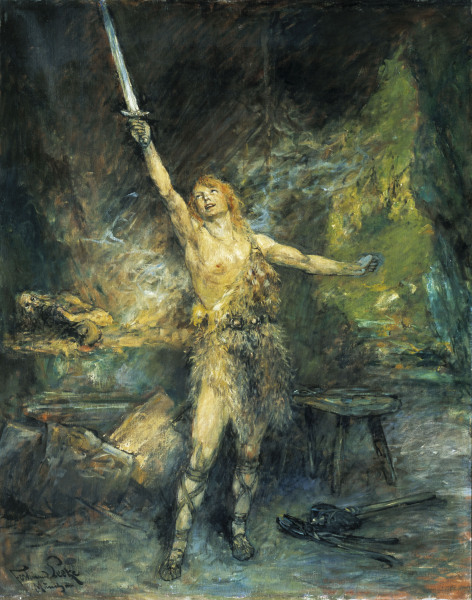Freer
Obsessive

I can’t
write hasty words
fast like
the speed of light;
throw in a
few broken pieces
of glass,
cuts on skins, show
the darkest
nooks of a soul
that has
bludgeoned under
an escalated
sense of anguish;
I wish for
an obsessive
to cry out
through my teeth
break them
in a beauty
of the metal
that bares its nails
yet sings a
symphony
an
orchestrated madness
yet a hero
with the sword
a stairway
of staccato words
yet
dissonantly coordinated
old-fashioned,
demure, cultured
yet
architecturally corrupted

Wagner's Ring -- Ferdinand Leeke
"Siegfried" was the third of four operas that constitute Richard Wagner's "Der Ring des Nibelungen" (The Ring of the Nibelung). It premiered at the Bayreuth Festspielhaus in 1876 as part of the first complete performance of The Ring cycle. He had begun the libretto in 1852 (based on an earlier viersion "Jung-Siegfried" (Young Siegfried) in 1851, and later entitled "Der junge Siegfried"), but he did not begin the musical composition until 1856 and did not complete it until 1871. He had initiated the operatic project with a libretto, "Siegfrieds Tod" (Siegfried's Death), which was eventually refashioned as "Götterdämmerung", the final section of the Ring cycle; "Jung-Siegfried" had been intended as a preferatory, comic, opera, to contrast with the tragedy of "Siegfrieds Tod." The composition of Acts 1 and 2 was completed by August 1857, but then Wagner turned his attentiion to "Tristan und Isolde" and "Die Meistersinger," and did not compose Act 3 until 1869. Although Wagner was not true to any particular version of the story, he derived much of it from 13th-century sources concerning Sigurd, the hero of the Icelandic" Völsunga saga;" the various tales (especially the "Thidrekssaga") about Dietrich von Bern, who battled Sigfried in some of them; and especially the epic "Nibelungenlied." The first act of the opera ic chiefly about the creation of a suitable word for Siegfried to slay the dragon Fafnir, which Siegfried himself accomplishes by reforging his father's broken blade, Nothung; the act closes wth Siegfried using it t chop the anvil in half.
ReplyDelete